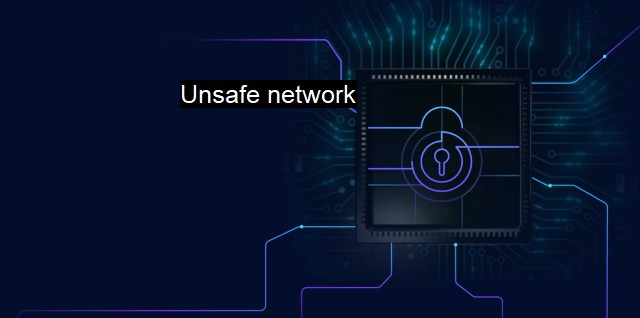What is Unsafe network?
The Rise of Cyber Threats: The Dangers of Unsafe Networks and How to Safeguard Yourself and Your Data
The term "unsafe network" frequently buzzes around, raising alarms for users, corporations, and cybersecurity experts alike. It represents a looming threat that can leave permanent implications if not managed properly. An unsafe network can be any internet or online environment where security measures are either subpar or nonexistent, creating a playground for hackers and cybercriminals.An unsafe or insecure network is prone to a myriad of cyber threats, such as phishing, malware, Trojans, and a cornucopia of other viruses and worms. Given the dynamism of technology, these attackers evolve more sophisticated methods that can sometimes bypass basic security measures, making an unprotected network a hotbed for malicious intents. Notably, features of unsafe networks include susceptibility to attacks, unauthorized access to sensitive information, potential of data breaches, system crashes, and loss of customer trust.
To delve deeper, let us consider an analogy: imagine the internet as a bustling city. In this city, there are safe neighborhoods with high walls, security personnel, alarms, and other essential safety precautions, reflecting our secure networks. On the other hand, there are hazardous regions scant of any security arrangements, crisp illustration of our unsafe networks. Just as criminals thrive in such insecure neighborhoods, cyber attackers find it relatively easy to operate in unsafe networks.
Unsafe networks are a significant issue primarily because of the valuable information that they often contain. These networks typically involve a plethora of personal, professional, financial, medical, national security, and corporate data that can grasp dire ramifications if fallen into the wrong hands. For hackers and cybercriminals, such data can be exploited and lead to identity theft, fraudulent transactions, sabotage, blackmail, or even international cybersecurity incidents.
The degree to which a network is unsafe closely correlates with its safeguarding measures; hence any network can be rendered unsafe if the necessary protection isn't installed. This is why as much as businesses today rely on digitization, cybersecurity concerns pose a harrowing reality. While web-based solutions offer immeasurable opportunities for growth and convenience, they simultaneously expose organizations to critical vulnerabilities if networks lack integral antivirus systems and firewalls.
Even for individual users, without proper security measures, simple acts such as online shopping, using a credit card, providing an email address or telephone number, or even engaging on social media platforms can expose them to cyber attacks. When on an unsafe network, a regular user instantly transforms into an open bank vault for these cyber criminals.
Antivirus software is a critical component in shielding networks from potential threats. Antivirus analyzes, detects, and removes malicious software from your devices, serving as the first line of defense against any impending threats. reliance on antivirus software alone is insufficient as viruses often mutate to circumvent antivirus detections and because antivirus software only limits damage post infiltration.
To enhance network safety beyond antivirus software, other proactive measures like Virtual Private Networks (VPNs), timely updates of software systems, robust firewalls, end-to-end data encryption, multi-factor authentication, regular backup practices, and continuous worker education on cyber safety rules and threat identification, should all intertwine to form a unified defense.
Considering the fierce velocity at which cyber threats evolve, cognizance of their new morphologies, preparedness for the shifting terrains, agility in responding to breaches, and commitment to fostering a security-conscious culture within an organization become core tenets for survival in this 'battlefield.'
An unsafe network in the context of cybersecurity is a network vulnerable to cyber threats due to leeway in its safety checkpoints, a haven for hackers, and seen as a hazard for users. Aligning defense strategies with the magnitude of risk posed on digital stages necessitates user discipline, powerful antivirus tools, evolved cyber safety tactics, and promoted awareness. In a time where our lives and operations are woven with the digital fabric, our survival simply morphs into resilience against cyber threats. Indeed, the journey towards a reliably secure network necessitates the transformation of unsafe networks into formidable fortresses that can withstand the onslaughts of cybercrime.

Unsafe network FAQs
What is an unsafe network?
An unsafe network refers to a computer network that is vulnerable to cyber attacks and is susceptible to unauthorized access or data breaches that can compromise the security and privacy of users.How can I protect my system from unsafe networks?
To protect your system from unsafe networks, you should install and regularly update antivirus software and firewalls, avoid connecting to public Wi-Fi networks, use strong passwords, and limit the amount of personal information you share online.What are some common types of cyber attacks on unsafe networks?
Some common types of cyber attacks on unsafe networks include viruses, malware, phishing, denial of service (DoS) attacks, and ransomware, among others. These attacks can lead to data theft, financial loss, and reputational damage.What are the consequences of using an unsafe network?
The consequences of using an unsafe network can be severe and can include identity theft, financial loss, loss of data, reputational damage, and legal repercussions. In addition, users may also be at risk of cyberstalking, harassment, and other forms of online abuse.| | A | | | B | | | C | | | D | | | E | | | F | | | G | | | H | | | I | | | J | | | K | | | L | | | M | |
| | N | | | O | | | P | | | Q | | | R | | | S | | | T | | | U | | | V | | | W | | | X | | | Y | | | Z | |
| | 1 | | | 2 | | | 3 | | | 4 | | | 7 | | | 8 | | |||||||